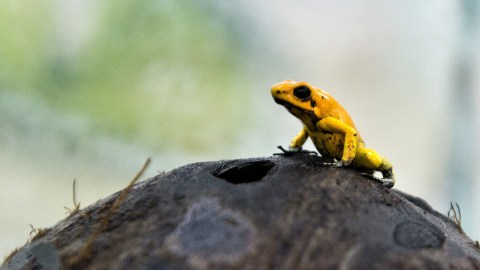Frogs Survived 4 Mass Extinctions, but Can They Survive the Present One?

Frogs aren’t given much thought in the popular media. Their story is one that stretches back to the days of Pangaea, but it’s coming to an end.
The Golden Frog is an amazing creature; its skin produces a toxin so powerful, a single gram of it could kill 100,000 people. But there’s not a single one left in the wild. Then there’s the Chile Darwin frog. Did you know the males of this species incubate their tadpoles in their vocal sacs for 60 days until they cough up their young? However, searches in its habitat have shown no sign the frog still exists. It’s believed to be extinct.
It’s the same story for many amphibians across the world. The Book of Frogs may be one of many books commemorating them as they slip into history, and of only a small portion (600 out of the 7,000 known species) of these amazing creatures.
Author Timothy Halliday provided his motivation for putting this book together, writing, “As frogs increasingly make headlines for their troubling worldwide decline, the importance of these fascinating creatures to their ecosystems remains underappreciated.”
More than 200 species of amphibiansare being brought down by a fungus, known as chytrid.
“Intense human pressure, both direct and indirect, is having profound effects on natural environments. The amphibians — frogs, salamanders, and caecilians — may be the only major group currently at risk globally.”
Researchers believe we’re entering a sixth extinction event caused primarily by climate change, though other factors also contribute — all directly related to human activities. What’s so interesting is that amphibians have endured through the last four mass extinctions.
Here’s a map showing the distribution and diversity of these amphibian species “using density-equalizing cartograms. Country size is distorted in proportion to the total number of amphibian species occurring in each country relative to its size.”

It’s the chytrid outbreaks that seem to be causing these mass extinctions. The fungus kills by blocking the frog’s ability to take in water and electrolytes through its skin. It’s been found in Central America, South America, North America, and Australia.
Why it has appeared in these distant parts of the world is uncertain, but scientists have two hypotheses. Both involve human influence. There’s the “Out of Africa” idea, which suggests the shipment of African clawed frogs, which are widely infected but unaffected by chytrid, may have introduced the fungus to many new environments around the globe. (African clawed frogs were used as a pregnancy test back in the 1950s and ’60s). Then there’s the “frog leg soup” hypothesis, where North American frogs where introduced to Europe, Asia, and South America for human consumption. (Not all of them may have made it into the cooking pot.)
The species who survive this blight will live out their lives in laboratories.
“We’ve got hope that somehow it’s all going to come together,” herpetologist Paul Crump told Elizabeth Kolbert, author of The Sixth Extinction. “We’ve got to hope that something will happen, and we’ll be able to piece it all together, and it will all be as it once was, which now that I say it out loud sounds kind of stupid.”
***
Photo credit: LUIS ROBAYO/AFP/Getty Images
Natalie has been writing professionally for about 6 years. After graduating from Ithaca College with a degree in Feature Writing, she snagged a job at PCMag.com where she had the opportunity to review all the latest consumer gadgets. Since then she has become a writer for hire, freelancing for various websites. In her spare time, you may find her riding her motorcycle, reading YA novels, hiking, or playing video games. Follow her on Twitter: @nat_schumaker





